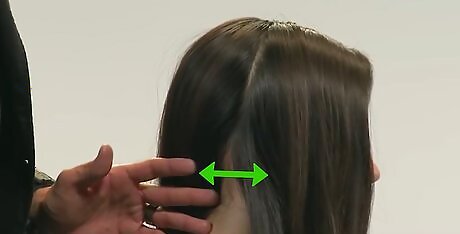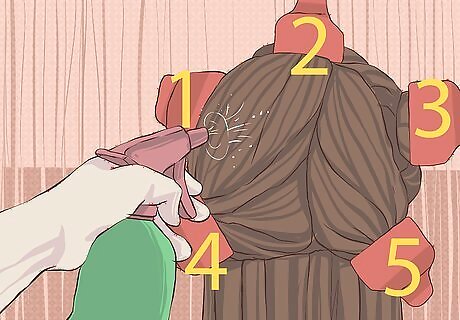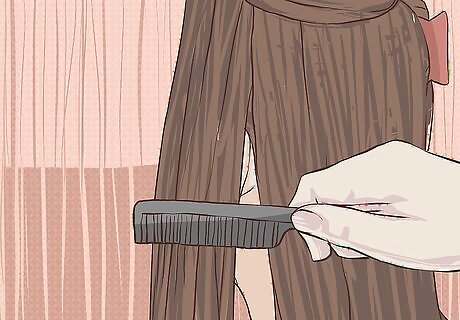
views
Parting Hair in Five or Seven Sections

Wet the hair. Fill a spray bottle with warm water. Saturated the hair with the warm mist—your hair should be damp, not dripping. Use a fine tooth comb to detangle your wet hair—carefully remove snarls and knots from the locks. Keep the spray bottle nearby. As the hair dries, re-wet the locks.

Divide the hair into five sections. The five-section part is used on clients with average to thinner hair. Part the hair down the center of the head—from the top of the forehead to the base of the skull. Part the hair horizontally at the top of the ears. This will create a section on the top of the head, known as the top box and two side sections. Twist each section and secure it with a large hair clip. Part the hair at the base of the ears. This will create a section at the base of your skull. Twist each section and secure it with a large hair clip. Make sure the right sections are even with the left sections.

Divide thicker hair into seven sections. If the hair you are cutting is thicker, consider dividing it into seven sections: top, right side, left side, right crown, left crown, right nape, left nape, and a ½ inch band of loose hair at the hairline. Begin by parting the hair in a straight line from just behind one ear to just behind the other ear. Create a part on each side of the head along the parietal ridge—approximately 4 finger widths above the tops of your ears. This will allow you to section off the hair on the top of the head. Comb the hair towards the top of the head, twist, and secure it with a clip. Comb, twist, and clip the hair on the left and right sides of the head. Part the hair down the center of the crown. To isolate the left and right crown sections, part the hair horizontally from just behind the ear to the center part. Comb, twist, and clip the two sections. Divide, comb, and clip the remaining hair at the nape of the neck into a left and a right section.
Layering Hair with the Aid of a Moving Guide

Divide the hair into five or seven sections. Before beginning this hair cut, part the hair into five or seven sections. Once complete, unclip each section one at a time. Remove a ½ inch section of hair along the perimeter of the hair line.

Create the first travelling guide. Unclip the bottom section. Gather a small segment of hair at the center of your bottom section. This segment will become the first traveling guide. A traveling guide moves with the area being cut. The most recently cut segment of hair in a section assumes the role of the traveling guide. It is held up to the next segment of hair and used as a ruler. Determine the length of the bottom layer. When you are deciding the length of the 3 layers, remember that the shorter the hair, the smaller the difference in the layers should be. The 3 layers may differ in 2 to 4 inches on long hair and 1/2 an inch to 1 inch on shorter hair. Insert the segment between the forefinger and middle finger of your non-dominant hand. Slide the fingers towards the ends—pulling the segment at a 90° angle—until your fingers have arrived at your desired hair length. Trim the excess hair with a pair of sharp shears. Consider cutting between ½ inch to 2 inches off—you can always go shorter!

Cut the remainder of the section. Use the travelling guide, the most recently cut segment of hair, to measure the length of the next segment. Insert the traveling guide and the next segment of hair between your forefinger and middle finger. Move the fingers towards the ends—pulling the hair at a 90° angle—until you reach the end of the traveling guide. Cut the new segment of hair so that it is the same length as the traveling guide. The freshly cut segment is now the travelling guide. Repeat the process until the entire section is cut. Check the evenness of your trim periodically. Pull the hair in multiple directions and at varying angles to check the evenness of the cut. Trim any uneven pieces before moving on to the next section of hair

Determine the length of the second layer. Unclip the left section and let and hang over the bottom layer. Use the bottom layer as a guide to determine how much hair to trim off the second layer. The bottom and middle layers may differ 2 to 4 inches in long hair and ½ inch to 1 inch in shorter hair.

Cut the left segment. Gather a small segment of hair at the front left side to use as your first guide. Pull the segment of hair straight at a 90° angle. Slide your fingers towards the ends of the hair until you reach the point you would like to cut off. Trim the excess hair. Cut the remainder of the section with the aid of the traveling guide.

Cut the right section. Unclip the right section. Gather a small segment of hair at the front left side (your travelling guide) and the front right side. Insert the two segments between your middle and forefinger and pull them forward at a 90° angle. Stop your fingers at the end of the left segment. Trim the excess hair from the right segment. Cut the remainder of the section with the aid of the traveling guide.

Determine the length of the top layer. Unclip the top section and let it hang over the middle layer. Use the layers below to help you determine the length of your top layer. The middle and top layers may differ 2 to 4 inches in long hair and ½ inch to 1 inch in shorter hair.

Cut the top section. Gather a small segment of hair at the top of the forehead. Pull the segment of hair straight at a 90° angle. Slide your fingers towards the ends of the hair until you reach the point you would like to cut off. Trim the excess hair. Cut the remainder of the section with the aid of the traveling guide.
Cutting Face Framing Layers

Wet, comb, and part the hair. Spray the hair with water until it is saturated. Detangle the wet hair with a comb. Part the hair down the center or to one side—ask your client where they typically part their hair. Comb the hair until it lays flat.

Section off the fringe area. Use a comb to create a fringe area along the perimeter of the front hairline. Part the hair from the left to the right sideburn. Comb this section forward so that it lies in front of the face.

Use a razor or scissors to create layers. Allow the perimeter hair to hang in front of the face. Choose a tool—use a razor for soft ends or scissors for blunt layers. Determine the length of the face framing layers—ask your client how short they would like their top layer. Use the razor or scissors to create a curved cutting line. Begin at the shortest point of the face framing layers and cut at a slight curved angle towards the ends of the hair—aim for the middle of the jawline.
Executing a Blunt Haircut

Wet and part the hair into five or seven sections. Spray the hair with water. Comb through the saturated hair to remove any knots. Part the hair into five or seven sections. Once complete, unclip each section one at a time. Unclip one section at a time and remove a ½ inch section of hair along the perimeter of the hairline.

Cut the front perimeter hair. Comb the wet hair along the perimeter of your forehead over the front of the face until it is straight. Allow the hair to hang as you determine the length of the hair. Without pulling on the hair, hold a one inch section just above the point at which you would like to cut. Use your shears to cut straight across the one-inch section. Using the previously cut section as a traveling guide, cut the hair remaining in the front section in this manner.

Cut the hair along the back and side perimeter. Comb the hair around the side and back perimeter of your hairline until it lays flat. Use a ruler or your comb to determine the amount of hair to cut off—it must match the front length. Start at the center back of the head. Without pulling on the hair, hold a one-inch section just above the point at which you would like to cut. Use your shears to cut straight across the one-inch section. Using the previously cut section as a traveling guide, work from the back to the front of each side.

Comb and cut the nape section(s). Unclip and section off a ½ inch layer of hair from the section(s) at the nape of the neck—start at the bottom of the section and work your way up. Comb the hair until it lays flat. Start at the center back of the head. Without pulling on the hair, hold a one-inch section just above the point at which you would like to cut—use the previously cut hair as your guide. Use your shears to cut straight across the one-inch section. Repeat this process until you have finished cutting the hair remaining in the nape section.

Comb and cut the side and crown sections. Unclip and section off a ½ inch layer of hair from the side sections—start at the bottom of the section and work your way up. Comb the hair until it lays flat. Start at the center back of the head. Without pulling on the hair, hold a one-inch section just above the point at which you would like to cut—use the previously cut hair as your guide. Use your shears to cut straight across the one inch section. Repeat this process until you have finished cutting the hair remaining in the side sections. If you divided your hair into seven sections, repeat this process on the crown sections.

Comb and cut the top section. Unclip and comb the top section—evenly distribute the hair on each side. Start at the center back of the head. Without pulling on the hair, hold a one-inch section just above the point at which you would like to cut—use the previously cut hair as your guide. Use your shears to cut straight across the one-inch section. Repeat this process until you have finished cutting the hair remaining in the top section.
Cutting and Trimming Blunt Bangs

Part and comb the hair. Section off the perimeter of the front hairline. Part the hair in a slight “U” from the right to the left temple to create a ½ inch bang section. Comb the bang section forward in front of the face.

Use the scissor tips to cut the center of the bang. Comb through the center of the bang section. Stop the comb a ¼ inch above the desired length. Use the tips of the scissors to cut the center bangs.

Trim to the left, then to the right. Using the center of the bangs as your guide, trim the left and right sides of the bangs. Comb through the left bang section. Stop the comb a ¼ inch above the desired length. Use the tips of the scissors to cut the left bangs. Repeat on the right bangs.

Check the evenness of the cut. Comb through the entire bang section. Observe the evenness of the cut or trim—keep an eye out for hairs you missed. Even out the bangs using the tips of the scissors.




















Comments
0 comment